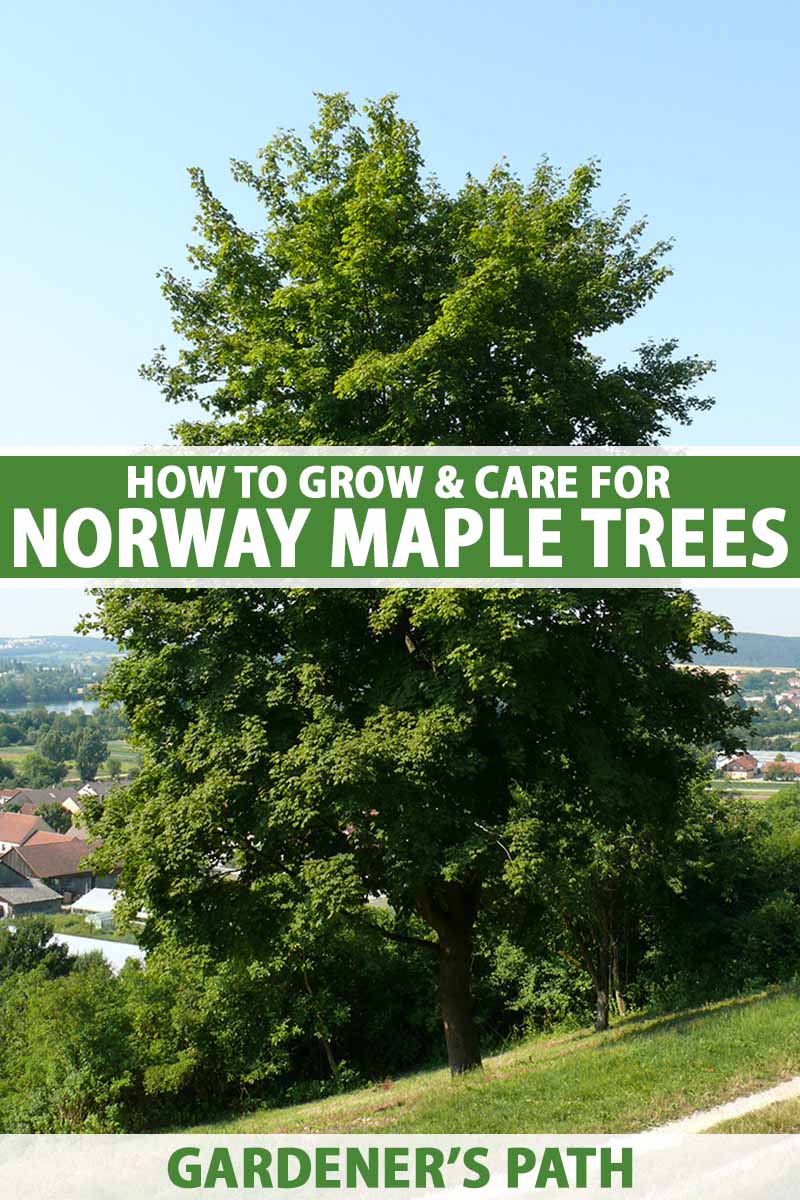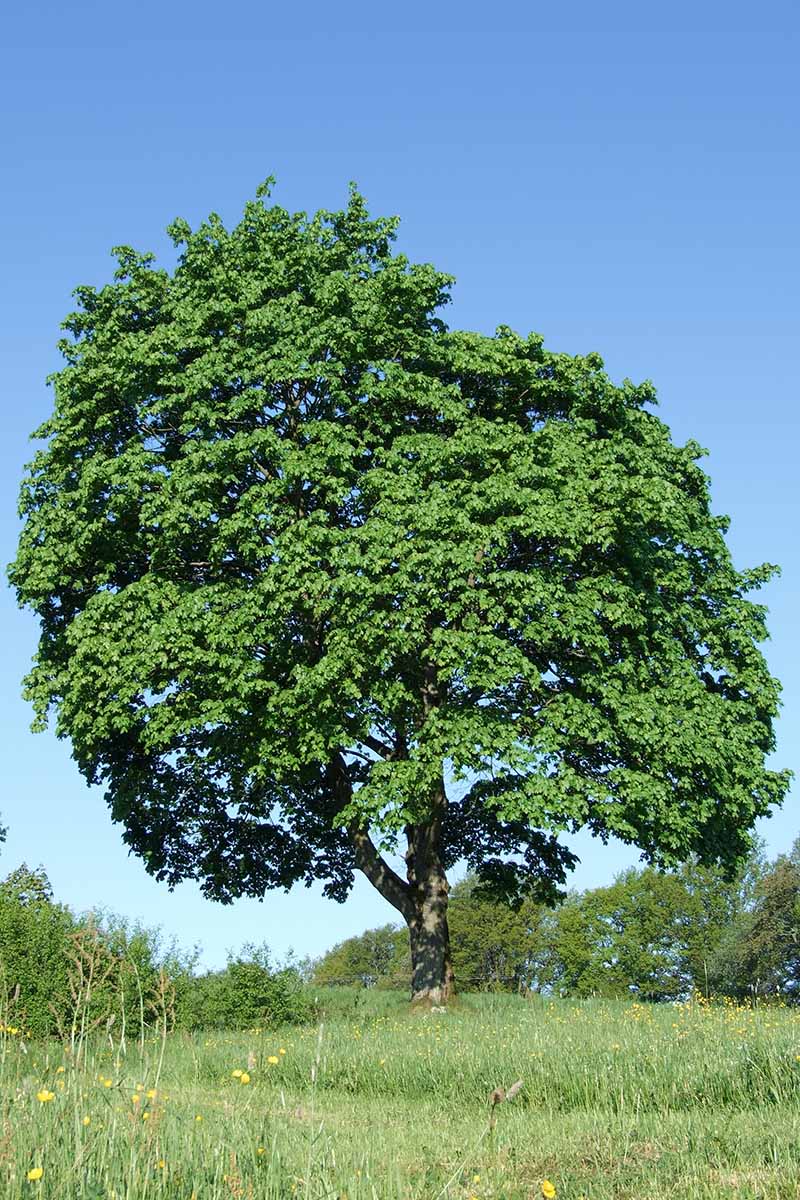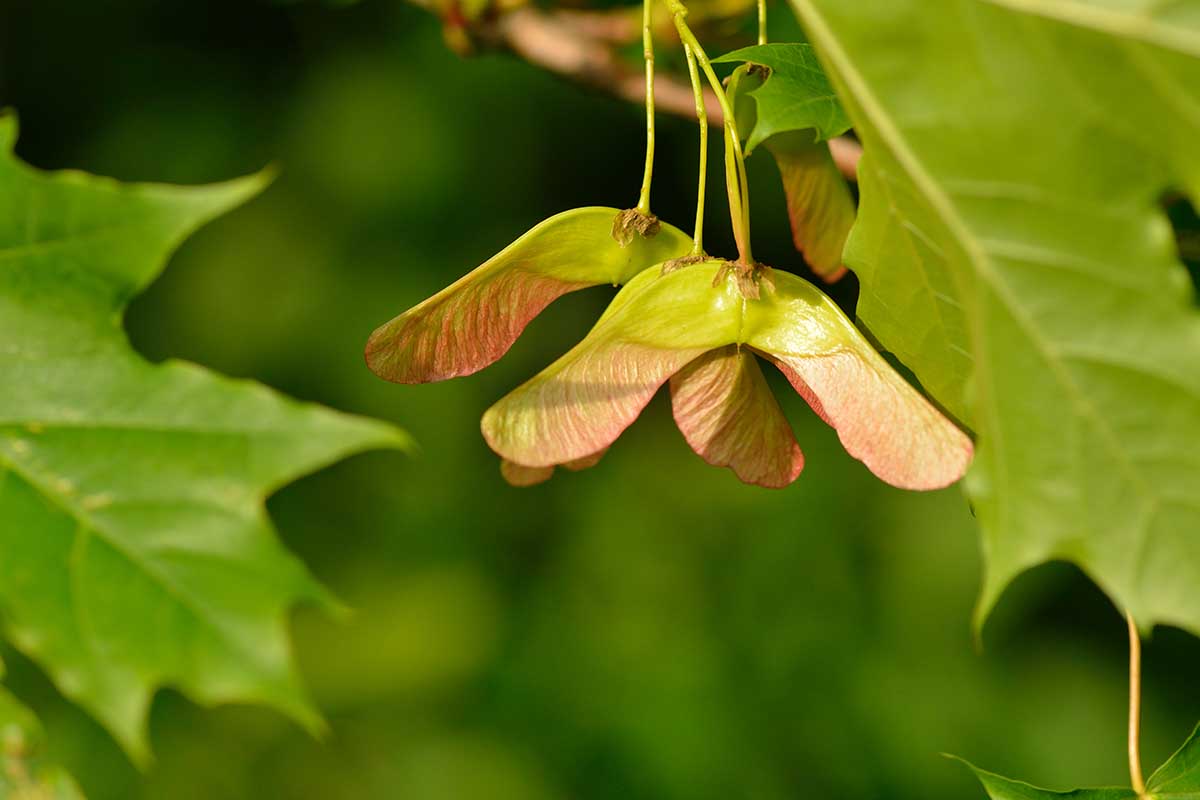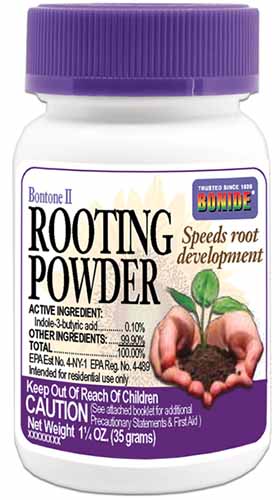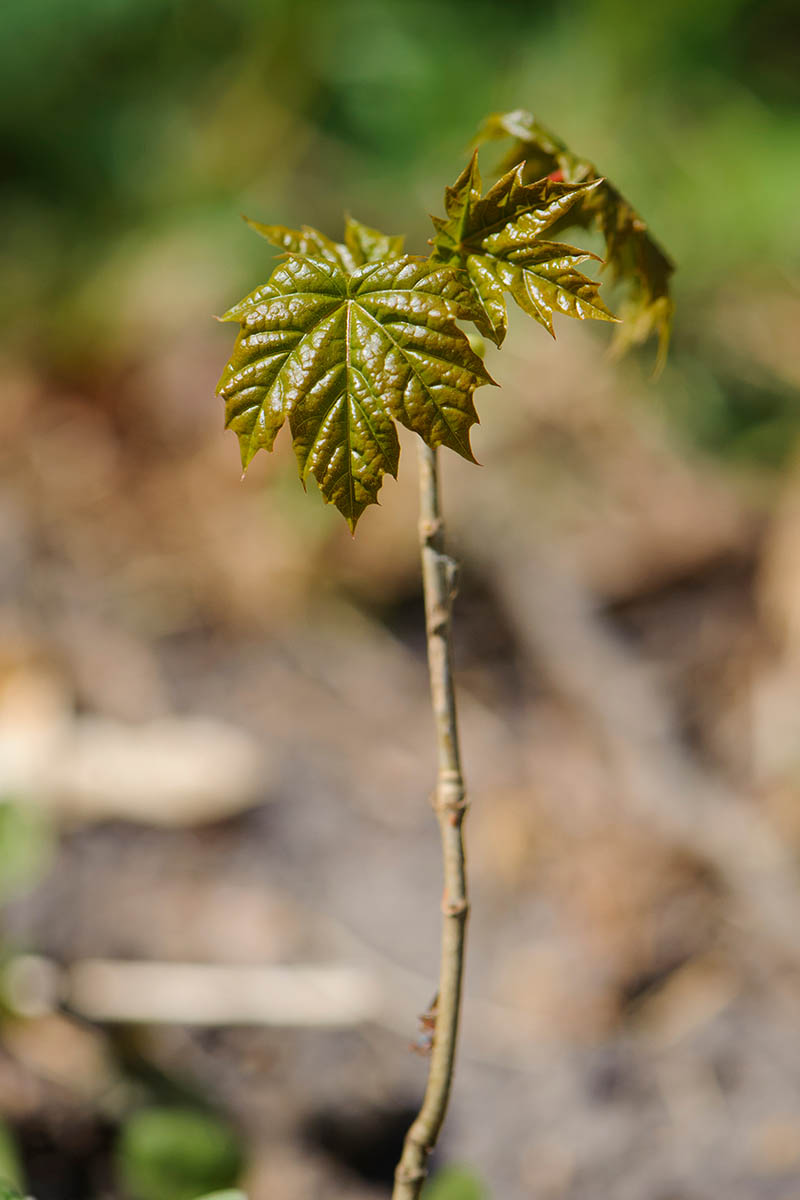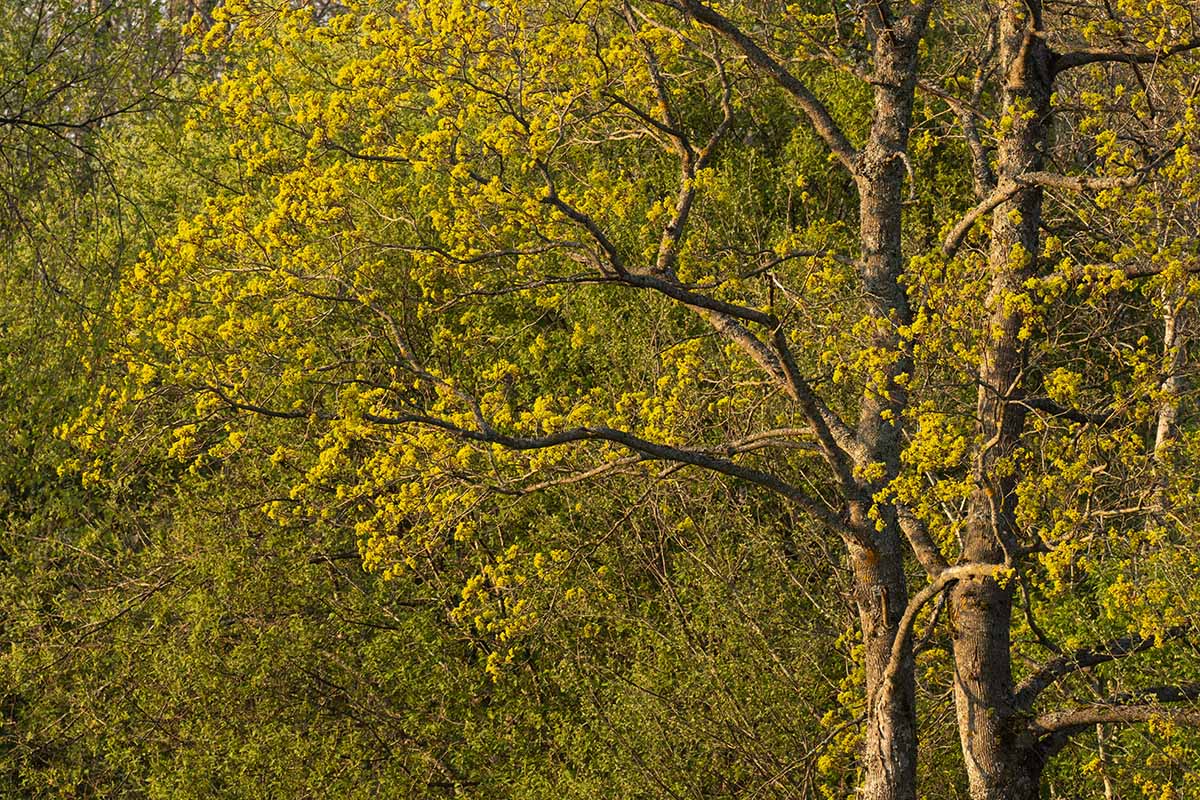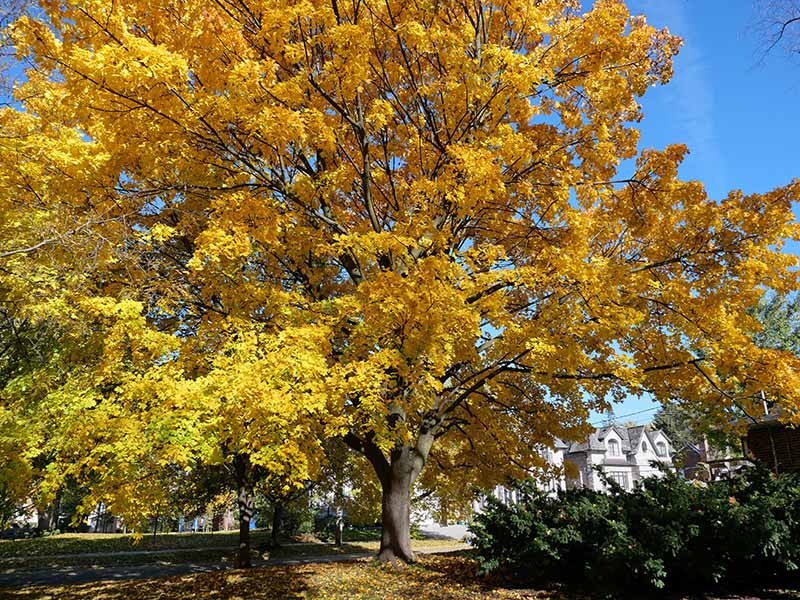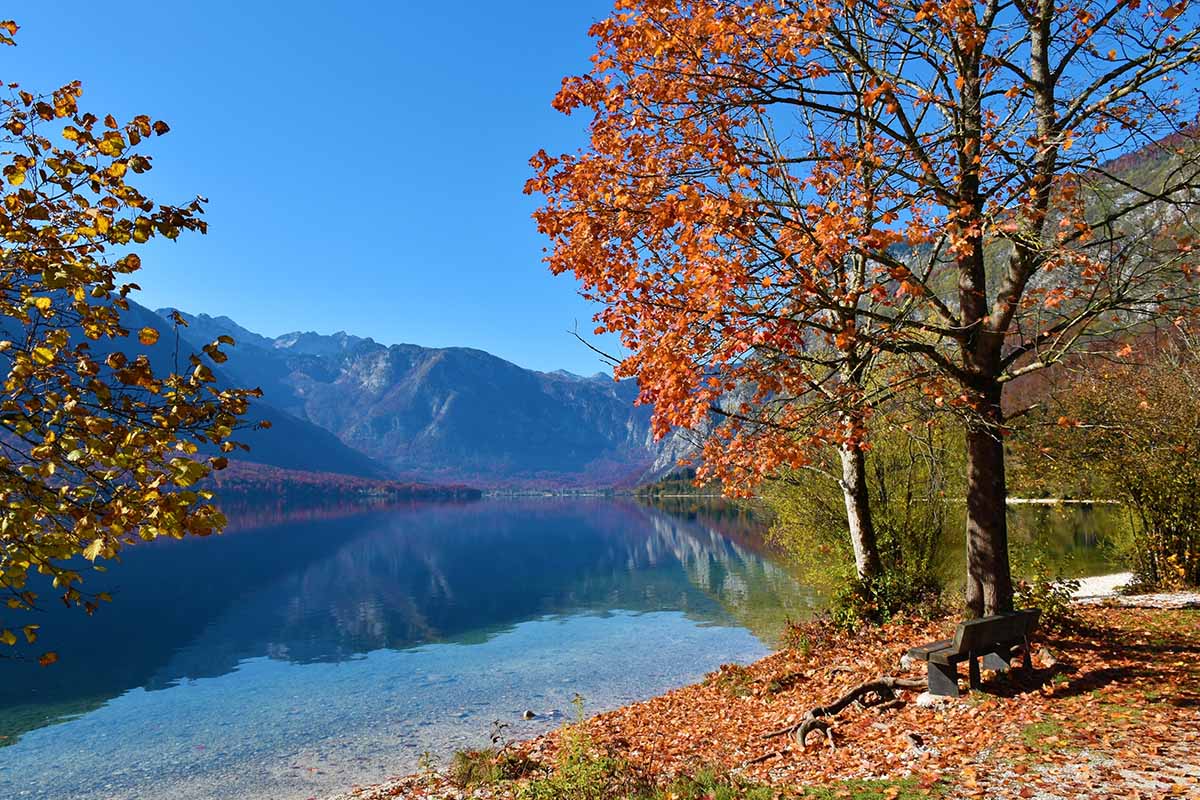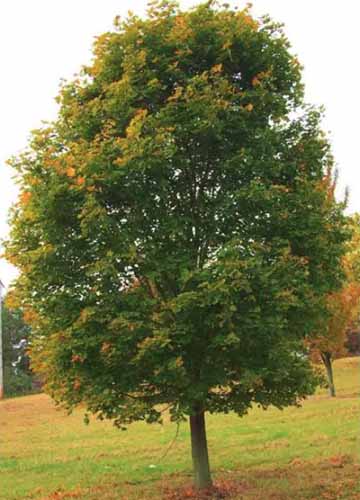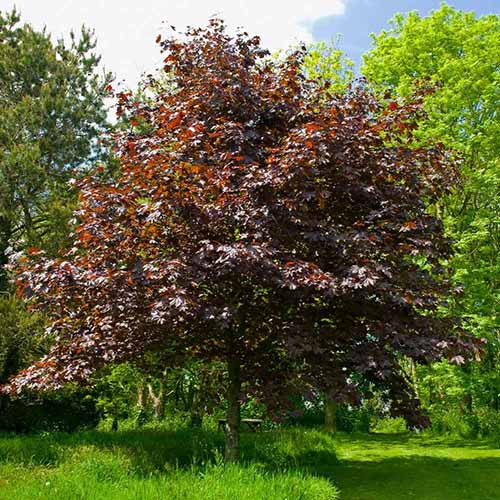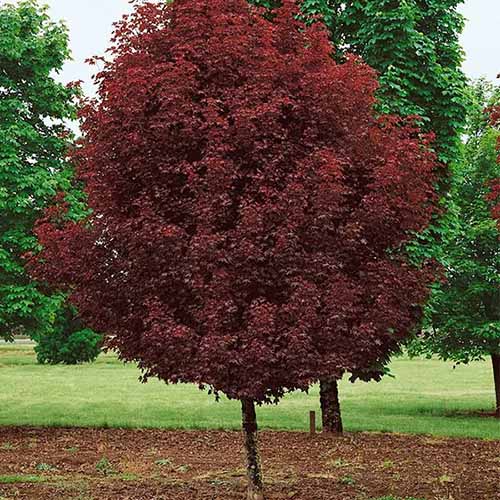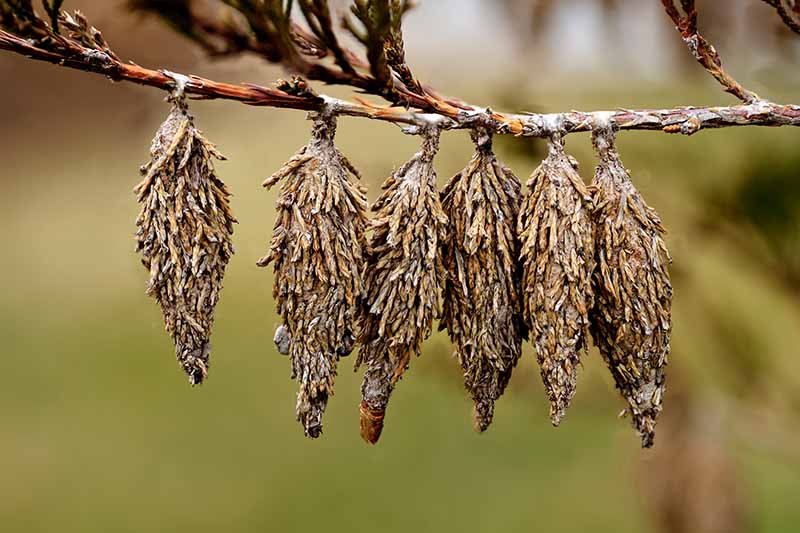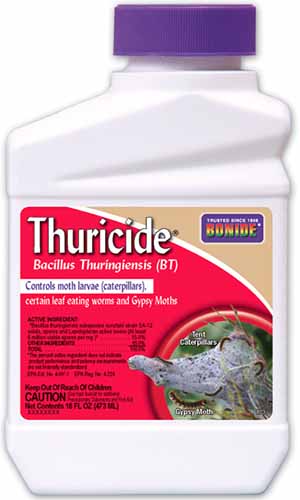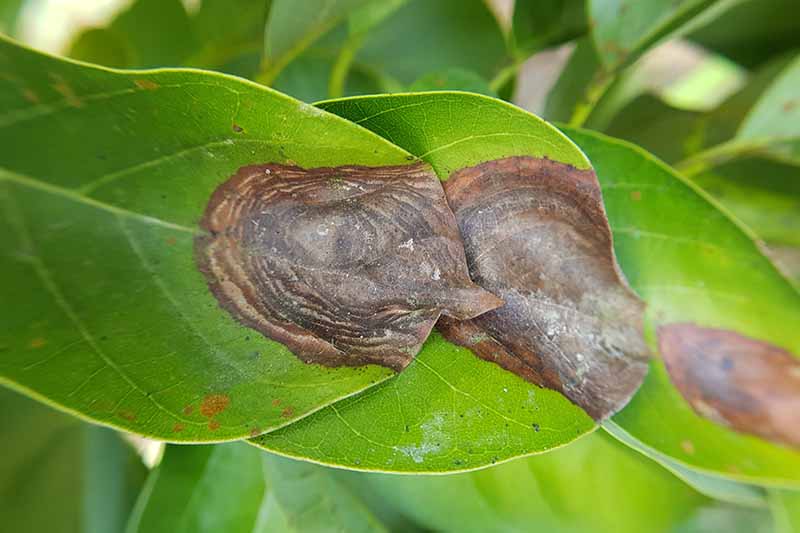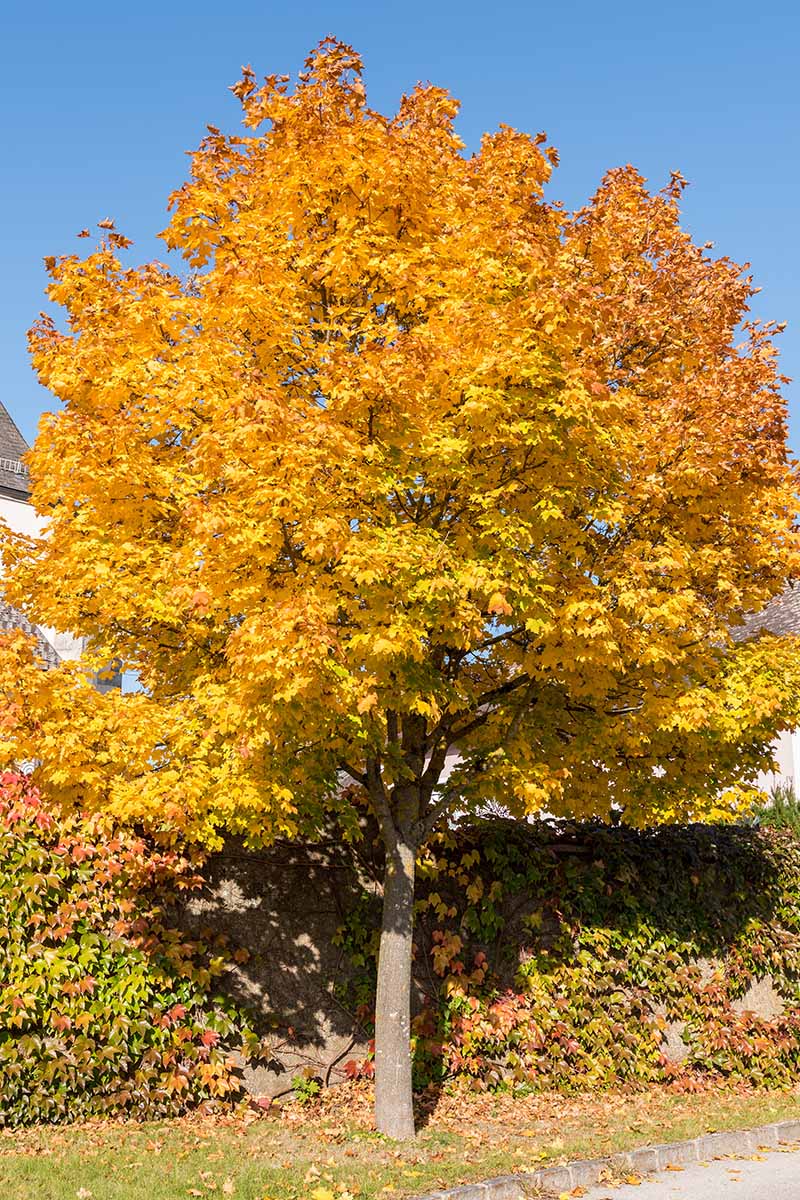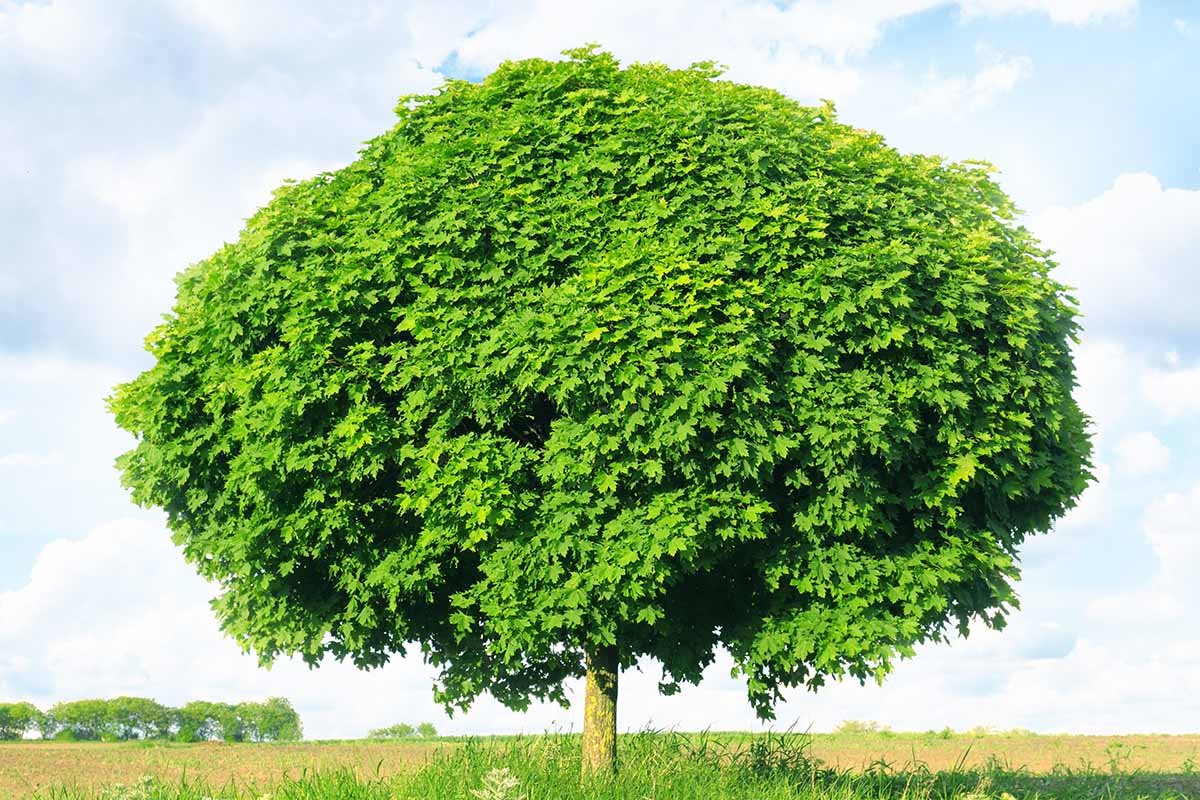We link to vendors to help you find relevant products. If you buy from one of our links, we may earn a commission. Another is the Norway maple, a species of Acer that’s known for its beauty, adaptability, and tolerance for a plethora of less-than-ideal growing conditions. This tree sports a rounded, symmetrical habit of densely-growing foliage that starts off a gorgeous dark green before changing to a striking yellow come autumn. It even looks amazing when defoliated, with furrowed gray bark that adds interesting texture to winter landscapes. In this guide on growing Acer platanoides, we’ll go over everything you need to know to cultivate handsome and healthy Norway maple specimens in your home landscape. Growing such an awesome plant may seem daunting, but any epic journey can be made doable by first breaking it down into simpler parts. Here are said simpler parts, coming up ahead:
Cultivation and History
Hardy in USDA Zones 4 to 7, A. platanoides is native to the central and eastern regions of Europe, as well as western Asia. Actually the most widespread native maple in Europe, growing as far west as northern Spain and as far east as Russia and Kazakhstan, its growth covers a broad range on the vertical plane also – it’s been found growing in river valleys as well as in mountain ranges! The Norway maple was cultivated in Great Britain as early as 1683 at the Edinburgh Botanic Garden. The tree was later introduced to the United States in 1756, and was being advertised in American seed catalogs by 1762. In the years that followed, A. platanoides became a popular planting in the United States and has remained so ever since, despite its invasive growing tendencies in some regions. At the time of writing, 17 US states have classified this species as invasive, including Delaware, Maryland, West Virginia, and Virginia. In addition, planting Norway maples is banned in Massachusetts and New Hampshire. Cultivars have been bred en masse to amplify certain characteristics in the landscape and/or curtail less desirable traits. The lumber of this plant is used to make furniture, flooring, and may have even been used in the construction of Stradivarius violins.
Propagation
Norway maple is best propagated from seed, from cuttings, or via transplanting. Let’s briefly go over all three options.
From Seed
As a member of the Acer genus, the seeds of Norway maples are encased samaras, which are seed pods shaped like single-bladed propellers. The “blades” of these samaras catch the air as the seed drops from the tree, which causes it to slowly descend in a spinning motion. This allows the seed pod to catch cross-breezes and land further away from the tree than it would have had it just fallen straight down instead. This ingenious method of seed dispersal allows A. platanoides to spread far and wide. Norway maples drop their seeds in the months of September and October, so you’ll have to be ready to collect them. You can wait until they drop from the tree, or you can pluck them off once they’ve developed a tan, desiccated-looking crinkliness. Either way, once you have the samaras, it’s time to peel back the flaky exterior to reveal the seeds within. These seeds have a low germination rate, so you’ll want to gather a lot more than you think you’ll need. Once you have your seeds, you’ll need to cold stratify them. You can let nature do the work by sowing them directly into a patch of fertile, well-drained soil. Sow the seeds a quarter-inch deep, and really pack them in there, with a seed density of 15 to 30 per square foot. You can also cold stratify indoors by placing your seeds in a plastic baggie filled with moist sand, and then refrigerating the seeds at 33 to 39°F for 90 to 120 days. Then plant them out as described above. You may be wondering why we would plant these seeds so densely. In a 2009 study published by the American Society for Horticultural Science in “HortTechnology,” A. platanoides germination rates ranged from zero to 23 percent, on average. With such a low germination rate, it’s essential to sow more seeds than you’d think you’ll need. You can thin them after they germinate. Water in the planted seeds, and keep the soil moist until the seeds sprout. If you’d prefer to start the seeds indoors, ready a 1020-sized plastic seed tray with a well-draining growing medium such as a 50/50 mix of sphagnum peat moss and perlite. Sow the seeds a quarter-inch to a full inch deep, and keep the medium moist. Once they’ve germinated, keep the tray adjacent to a sunny window, where it can receive indirect light for at least half of the day, and maintain even moisture. You can start hardening off the seedlings in spring once they have three to four true leaves and have developed a solid root system – check by gently pulling on the seedlings to see if they give way. If the root systems check out, leave the seedlings outside for 30 to 60 minutes before bringing them back indoors. Add another 30 to 60 minutes to the time spent outside on each subsequent day until the seedlings are conditioned for a full day’s exposure.
Transplanting
Early spring or fall are ideal times for transplanting. Remove the foliage from the bottom half of the cutting, and apply a rooting hormone to the defoliated end. A high-quality product is this IBA powder sold by Bonide, which is available from Arbico Organics. Bonide Bontone II Rooting Powder Next, fill a four-inch plastic pot with a half-and-half mix of sphagnum peat moss and perlite. Stick the cutting in, cut end down, and moisten the growing medium. Place the pot adjacent to a window that receives indirect sunlight for most of the day, making sure to keep the soil moist as it roots. It’ll be hardening-off time once the cutting has developed an extra pair of leaves or two. Follow the same protocol you’d use to harden off seedlings before transplanting as described below. In a suitable location in your garden, section off fertile soil with good drainage for each specimen that you plan on transplanting, whether they’re seedlings, rooted cuttings, or simply specimens that you’ve purchased at a nursery or through the Interweb. If you started from seed, select the largest and healthiest seedlings for planting. If you have leftover seedlings, feel free to give them away to friends and family… who have been cleared to plant a Norway maple in their area, that is! Make sure each transplant location isn’t under any power lines or other tree canopies, and give each transplant a 30-foot radius of horizontal clearance, to account for mature spread. For the health of the transplants, it’s best that they have plenty of room to grow and develop. Prepare holes about the depth and width of each transplant’s root system. Put the transplants in the holes and backfill with the adjacent, dug-out soil. Deeply irrigate each transplant, and keep the soil evenly moist as the plant becomes established.
How to Grow
A Norway maple is well-renowned for its durability, especially against heat, polluted air, and urban conditions. Heck, you might have selected one just so it would add some greenery to an area with some shoddy conditions that you’re stuck with. But an A. platanoides isn’t too tough to benefit from a little TLC. When you provide ideal growing conditions for this tree, you’ll be rewarded with vibrant health and vigor.
Climate and Exposure Needs
This tree needs to be grown in USDA Hardiness Zones 4 to 7 in order to thrive. It prefers full sun, but partial shade works as well. It’ll even tolerate full shade, especially while in its juvenile stages for the first few years of growth.
Soil Needs
The Norway maple can handle growing in sand, clay, and anything in between. The soil doesn’t even have to be all that fertile, although high fertility is preferable. But try and provide some decent drainage, if at all possible. Additionally, it might behoove you to choose a moist, well-draining planting site to begin with… might save you some work on irrigation. As far as acidity and alkalinity goes, a pH of 4.0 to 7.5 is survivable, although a more narrow range of 5.5 to 6.5 is optimal. Aim to land somewhere on the acidic side of neutral, and conduct a soil test before planting if you need to.
Irrigation and Fertilization Needs
Although this tree prefers that its soil is kept evenly moist – in a well-draining location, that is – it also possesses some decent drought tolerance once established and when it’s mature. This shouldn’t be taken as license to blow off irrigating entirely, but rather, it’s a saving grace for forgetful gardeners. Feel free to boost the soil’s fertility by working a couple inches of compost or well-rotted manure into the soil above the root zone each year in early spring.
Growing Tips
This tree tolerates full shade… but it can grow all right in partial shade, and prefers full sun.A Norway maple can tolerate various soil textures and fertility levels, but fertile soil with good drainage is ideal.Keep the soil moist at all times if possible, but you have the plant’s drought tolerance to thank in case you forget to irrigate during periods of hot and dry weather.
Pruning and Maintenance
A. platanoides benefits from some well-executed pruning – our guide to pruning maple trees can be found here. Norway maple leaves persist later in fall than native maples, and they may hang on to the trees through mid-to-late November. But after Thanksgiving and into early winter, you can expect the foliage to start slowly falling, and these leaves may need to be raked up. The Norway maple does have some traits that allow it to grow invasively, such as early flowering, releasing allelopathic chemicals that impede the growth of certain other plants, and the ability to naturalize in woodlands while outcompeting native plants. The same qualities that made it a prolific maple in Eurasia can make it a real pain to keep contained here in The New World under the right conditions. All this to say, as your A. platanoides grows and develops, you may find that volunteer sprouts are popping up in spots where you don’t want them to, thanks to the easily spread samaras. To combat this, pull seedlings as they sprout, rake up the fallen samaras particularly in areas where you don’t want them to spread, and snip suckers away from the trunks of established Norway maples as they appear. Another thing worth mentioning: frost cracking. Much like concrete in winter, wood cools and contracts as it gets colder out. When the temperature drop is sudden and rapid, a Norway maple’s external bark shrinks faster than the underlying sapwood, which causes it to fissure and split. These splits happen all at once in an explosive fashion, letting off a loud, gunshot-esque crack. With an equal height and spread of 15 to 20 feet, this variety has a densely globular habit with sharply-toothed green leaves that turn a striking yellow in fall. In addition, use a sterilized blade to trace around the wound and leave a clean half-inch margin between the wound and your incision – this will stimulate cambium regrowth and speed up healing.
Cultivars to Select
The standard A. platanoides is certainly a beaut, and it is available as a bareroot, three- to four-foot-tall transplant from The Home Depot. Acer platanoides But it would be remiss of me if I didn’t mention the available cultivars, which have been bred for ornamental traits not found in the regular ol’ species. Let’s go over some top-tier options.
Crimson King
Reaching a height and spread of 45 by 30 feet, ‘Crimson King’ is notable for its leaves, which remain a maroon or purple-green color throughout the growing season. The foliage darkens and turns bronze in fall, while the inconspicuous flowers bloom in hues of maroon-yellow in the spring. Hardy in Zones 3 to 7, this cultivar is a bit more resistant to cold than the standard species. The rounded canopy of this cultivar is symmetrical, and the habit hardly varies between different specimens of ‘Crimson King,’ making it an ideal cultivar for planting all in a row along a border or fence line. ‘Crimson King’ To purchase a ‘Crimson King’ in three- to four-, four- to five-, or six- to seven-foot-tall sizes, visit Fast Growing Trees.
Crimson Sentry
A bud sport of ‘Crimson King’ with similar coloring, ‘Crimson Sentry’ is a dense and columnar variety that doesn’t grow taller or wider than 25 by 15 feet. This compact size makes it ideal for scenarios where you might wish to plant another type of Norway maple but don’t have the room. Additionally, ‘Crimson Sentry’ is slower-growing than ‘Crimson King.’ If you’re a plant parent who wipes a tear from their eye as you reflect on how “they grow up so fast,” then ‘Crimson Sentry’ is the perfect variety to enjoy as a juvenile for a little while longer than normal. ‘Crimson Sentry’ ‘Crimson Sentry’ is available from Nature Hills Nursery.
Globosum
If you’ve ever wanted a Norway maple in the shape of a massive lollipop, then ‘Globosum’ is the cultivar for you. It maintains its compactly rounded form as it grows, so no need for pruning!
Stand Fast
If ‘Globosum’ can be described as “leaves on a stick,” then ‘Stand Fast’ could be viewed as a stick… that’s covered with leaves. With dark green, crinkled leaves that turn red in autumn, this cultivar reaches a height of 20 feet and a width of three feet, at most. If you’re looking for that stereotypical Norway maple shape, then you’ll be disappointed. But for an A. platanoides variety that fits exceptionally well in tight vertical spaces, while also being a unique oddball in the landscape, ‘Stand Fast’ will pleasantly surprise you.
Managing Pests and Disease
For keeping a Norway maple at peak health, it’s essential to keep it free from infestation and infection. Aside from the following tips and tricks, simply cultivating your A. platanoides properly according to recommended guidelines for planting and care will go a long way in keeping pests and pathogens away.
Insects
Insects can vector pathogens at times, so proper pest management also has the fringe benefit of preventing the occurrence of certain types of disease.
Bagworms
Belonging to the same order as moths and butterflies – Lepidoptera – bagworms are no joke.The larvae heavily feed on upper leaf tissues, and sometimes the damage is enough to kill an entire plant. Adult males appear in typical moth fashion, with black bodies and clear wings. Adult females, however, don’t look remotely like the males. They are eyeless, legless, wingless, antennae-less creatures with no functional mouthparts. As larvae, these pests build “bags” from silk and adjacent plant material. The females never leave their bags, while the males leave their bags upon maturity, fly to a nearby female’s bag, mate with the female, and then die in a matter of days. This pest is distributed solely in areas where A. platanoides can be found, and its presence is welcomed by those who believe the Norway maple to be an invasive nuisance. But for those fond of A. platanoides, Norway maple aphids are bad news. The best way to control bagworms is with the beneficial bacteria known as Bacillus thuringiensis kurstaki, which can be devastating to bagworm populations if it’s applied during the larval phase. Bonide Thuricide Bonide sells this bacteria as a liquid concentrate in various volumes, available from Arbico Organics.
Leafrollers
The term “leafroller” refers to the larvae of certain moths from the Torticidae family. These leafrollers earned their name from the way they roll and web up a leaf around themselves for protection as they feed on foliar tissues. In general, leafrollers are slender, reach two-thirds of an inch in length, and have a green body with a black head. Infested foliage appears rolled up, with webbing in place to keep the leaf closed. The damage sustained from leafrollers isn’t severe enough to pose a health risk, but it can be an ornamental nuisance. Chemical controls include sprays of neem oil and applications of the microbial insecticide Bacillus thuringiensis. Additionally, beneficial insects such as lacewing larvae and assassin bugs feed on leafroller larvae. Natria Neem Oil
Norway Maple Aphids
An invasive European species, Periphyllus lyropictus only has one host in North America: the Norway maple. P. lyropictus comes in both winged and wingless forms. Wingless Norway maple aphids are a greenish-yellow color, with brown markings on the abdomen. Winged P. lyropictus are larger, black-bodied, clear-winged, and have legs with both yellow and black segments. Large infestations of Norway maple aphids cause foliar browning and wrinkling, along with premature leaf drop. They also excrete honeydew as they feed, which causes damage to plant structures, attracts other insects, and is a causal agent for black sooty mold. Applications of horticultural oil in the dormant season work as a preventative measure, and strong sprays of water can physically knock P. lyropictus off of leaf surfaces. Ladybugs are a natural predator of Norway maple aphids, and their presence can help to decrease P. lyropictus populations. You can learn more about how to deal with aphids in our guide.
Disease
Gardening can be dirty work, but that doesn’t mean you should be unsanitary about it. Utilizing sterilized tools, pathogen-free soil, and healthy transplants are all solid ways of keeping your garden sanitary, which will help prevent disease from occurring.
Anthracnose
A fungal disease commonly occurring in shade trees, anthracnose tends to strike in weather that’s simultaneously wet and cool. The causal fungi, Colletotrichum gloeosporioides, overwinters in plant structures and nearby fallen detritus, and anthracnose spores spread via wind and water. Symptoms include irregularly shaped tan-to-brown spots or blotches on foliage, and afflicted young leaves are often curled, cupped, or otherwise distorted. Severely infected trees may drop their leaves early in spring, but thankfully grow a second round of leaves by midsummer if otherwise healthy. Most of the time, you don’t have to do much for anthracnose-riddled trees, as healthy leaves will eventually replace the infected ones. However, fungicides can help if severe defoliation has occurred for years on end. Proper fungicide application over the entire tree may require the aid of a professional arborist.
Tar Spot
Caused by fungi from the Rhytisma genus, tar spot shows up on infected leaves as yellowish spots which start out an eighth of an inch in diameter, but can grow to be three-quarters of an inch across. Infected Norway maple foliage can develop small black structures an eighth of an inch in diameter that resemble blobs of tar. This damage caused by this disease is purely a cosmetic issue. Future tar spot outbreaks can be prevented by properly disposing of fallen leaf detritus.
Verticillium Wilt
The most serious affliction on this list, Verticillium wilt is caused by species of Verticillium fungi, which overwinter as microsclerotia in the soil. This disease enters root openings or wounds and essentially clogs a plant’s xylem, so that water can’t travel where it needs to go. This manifests in the foliage as leaf wilting, yellowing, and margin scorching. Additionally, maple sapwood can exhibit greenish streaks. This disease can cause plants to die in as little as a few weeks, or over a period of several years. Other than proper sanitation and cultivation practices, there’s not much you can do about this disease. You’ll just have to pitch the infected plant and start over somewhere else. Verticillium fungi persist in infected soil indefinitely, so you’ll have to utilize that growing space for some Verticillium-resistant plantings instead.
Best Uses
Whether it’s planted in a rural or suburban area, the Norway maple is a perfect tree for large open spaces, providing ample shade and ornamental interest.
Quick Reference Growing Guide
The Maple from Norway: It’s Here to Stay
Many folks look down on a plant the second they find out it’s non-native. While it’s important to be ecologically-conscious, a plant with invasive growing tendencies doesn’t necessarily have to be shunned. As long as you pay attention to local planting regulations and watch for unwanted spread, a Norway maple can truly add some exotic beauty and toughness to your garden. Any comments or questions about A. platanoides can go into the comments section below. Your notes can help all of us gardeners to learn from each other, so don’t be shy! For more guides on growing maple trees, feel free to dive right into these Acer articles next:
How to Grow and Care for Maple TreesHow to Grow and Care for Red Maple Trees15 of the Best Types of Maple Trees to Grow at Home
